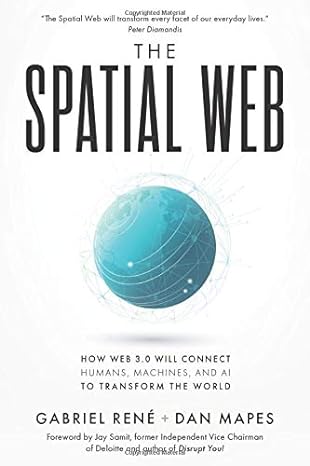I’m a blogger and into technology so you would expect most of what I read to come from the internet. Well, you’re right. But I also find a good deal of value in reading physical books, that dive deeper into a topic than the 20 second video clips or short blog posts. Often times, if you want to learn deeply about a topic online, you have to visit several sources. That is not inherently undesirable, but sometimes it’s nice to just pick up a book and read. That’s what I did with “The Spacial Web.”
“The Spatial Web: How web 3.0 will connect humans, machines and AI to transform the world” is a visionary exploration of the future of the internet, positing a transformative shift from our current digital experiences to a fully integrated physical and digital reality. Authored by leading figures in technology and innovation, the book lays out a future where the internet escapes the confines of screens and devices to become an omnipresent layer within our physical environments. This new paradigm promises a leap towards more intuitive, immersive, and accessible interactions with digital information, woven directly into the fabric of our daily lives.
Conceptual Underpinnings
At its core, “The Spatial Web” introduces readers to a future where augmented reality (AR), virtual reality (VR), and Internet of Things (IoT) technologies merge to create a seamless interface between our physical world and digital data. The authors do an exceptional job of demystifying complex concepts, making the idea of a 3D internet accessible to those without a technical background. Through a blend of real-world examples and hypothetical scenarios, they paint a vivid picture of how this next-generation internet could enhance human experiences, streamline processes, and foster unprecedented levels of interconnectedness.
Transformative Applications
One of the most compelling aspects of “The Spatial Web” is its deep dive into the myriad applications of this emerging technology across various sectors. From revolutionizing healthcare with augmented surgical visualizations to transforming education through immersive historical experiences, the book offers a glimpse into a future where digital enhancement becomes a natural part of every aspect of life. Retail, transportation, and urban planning are just a few of the industries poised for disruption, with the Spatial Web enabling new efficiencies, personalizations, and user experiences.
Addressing Challenges
While the book champions the vast opportunities presented by the Spatial Web, it also thoughtfully addresses the significant challenges and ethical considerations that accompany such a paradigm shift. Privacy, security, and the digital divide are among the critical issues discussed, underscoring the necessity of conscientious development and implementation strategies to ensure the equitable distribution of the Spatial Web’s benefits.
Impact on Domain Names and Investing
An intriguing aspect of “The Spatial Web” that deserves particular attention is its potential impact on domain names and domain name investing. As the internet becomes more integrated into our physical spaces, the value and significance of domain names could undergo a radical transformation. The book speculates on a future where digital real estate becomes as critical as physical real estate, suggesting that domain names might evolve into virtual location identifiers within this new web infrastructure.
For domain name investors, this shift represents both a challenge and an opportunity. Traditional strategies focused on acquiring and trading generic or keyword-rich domains may need to adapt to accommodate the nuances of virtual space navigation. The importance of intuitive, memorable, and brandable names could increase, reflecting their role in guiding users through immersive digital environments. Furthermore, the book hints at the emergence of new forms of domain name extensions or identifiers designed specifically for navigating the Spatial Web, presenting a new frontier for investment and speculation.
“The Spatial Web” is not just a book about the future of technology; it’s a roadmap for navigating the impending fusion of our digital and physical realities. With its insightful analysis, vivid examples, and thoughtful consideration of both the opportunities and challenges ahead, it stands as a crucial read for anyone interested in the evolution of the internet. For tech enthusiasts, industry professionals, and domain name investors alike, this book offers valuable insights into the next major revolution in digital connectivity, highlighting the strategic considerations that will define success in this new era. Whether you’re driven by curiosity or professional interest, “The Spatial Web” provides a comprehensive and engaging guide to understanding and preparing for the future of the internet.



